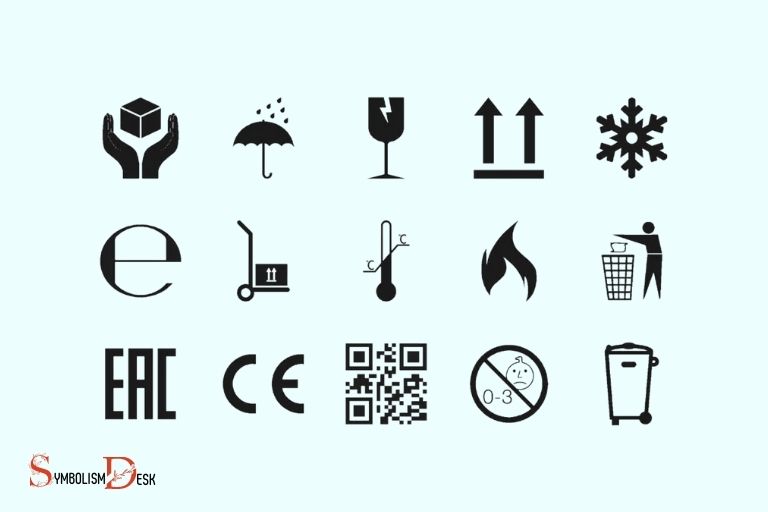Symbols on Food Packaging And What They Mean: Explain!
Symbols on food packaging serve as a guide to consumers about the product they are purchasing.
They provide information about the nutritional content, recycling instructions, production methods and other important details like the product’s expiry date.
These symbols are standardized by regulatory bodies to ensure consistency and clarity.
Symbols on food packaging are part of a regulatory process to ensure the safety, health and information rights of consumers.
They give insights about the ingredients, allergens, nutritional value, and origin of the product.
They also inform about the packaging’s recyclability and provide guidelines for safe storage and usage. Understanding these symbols can help consumers make informed decisions about the food products they buy.
It is vital to understand the symbols on food packaging as they offer crucial information about the items we consume.
These symbols guide us in making healthier choices, avoiding allergens, reducing waste and ensuring that we consume food products safely.
By paying attention to these symbols, customers can make informed decisions that cater to their dietary needs and lifestyle preferences.
11 Symbols on Food Packaging and Their Meanings
| Symbol | Meaning |
|---|---|
| Green Dot | This symbol means that the packaging is recyclable, or that the manufacturer has made a financial contribution towards the recovery and recycling of packaging. |
| Tidy Man | This symbol is a reminder to consumers to dispose of the packaging in a bin, rather than littering. |
| Mobius Loop | This symbol means that the packaging is capable of being recycled. A percentage in the middle of the loop may indicate the percentage of recycled material used. |
| PEFC | Programme for the Endorsement of Forest Certification. This symbol means the packaging comes from a sustainably managed forest. |
| FSC | Forest Stewardship Council. This symbol means the paper products are sourced from sustainably managed forests. |
| Resin Identification Code | This is a set of symbols ranging from 1 to 7 that identifies the type of plastic used in the product. |
| Leaping Bunny | This symbol indicates that the product is cruelty free and not tested on animals. |
| Vegan Society Trademark | This symbol indicates the product is suitable for vegans. |
| Fairtrade Mark | This symbol indicates that the product meets certain ethical and environmental standards. |
| Gluten Free | This symbol indicates that the product does not contain any gluten. |
| Rainforest Alliance Certified | This symbol indicates that the product has been produced sustainably and ethically. |
Key Takeaway

Five Facts About: Symbols on Food Packaging and Their Meanings
What Are Symbols On Food Packaging And What They Mean?
Whether you’re trying to follow a specific diet or are simply looking for particular ingredients, symbols on food packaging can be incredibly helpful in making smart choices.
But what exactly are symbols on food packaging, and what do they mean?
Let’s dive in.
Definition Of Symbols On Food Packaging
Symbols on food packaging are graphic representations that communicate information regarding the content, production, and safety of the food product.
These symbols are recognized by regulatory bodies and organizations and are used to guide consumers in making informed decisions.
Types Of Symbols On Food Packaging
There are various types of symbols on food packaging, but some of the most common ones are:
- Certification marks: Logos or seals indicating that a product has been approved by a particular organization, such as usda organic or fairtrade certified.
- Allergen symbols: Small images that specify the presence of common allergens, such as peanuts, shellfish, or dairy.
- Recycling symbols: Numbers or images that show which materials can be recycled or how to dispose of the packaging.
- Nutrition symbols: Quick guides to the nutritional value of the product, such as the heart-check mark that indicates a product is low in saturated fat, cholesterol, and sodium.
Pinpointing The Meanings And Significance Of Symbols On Food Packaging
Understanding the meaning of symbols on food packaging can help consumers make better choices for their health, lifestyle, and the environment.
Here are some possible meanings and significance of common symbols:
- Usda organic: Indicates that the product has been produced without the use of synthetic pesticides and fertilizers, genetically modified organisms (gmos), or irradiation.
- Gluten-free: Means that the product does not contain gluten, a protein found in wheat, barley, and rye that can trigger celiac disease or gluten intolerance.
- Non-gmo: Indicates that the product does not contain genetically modified organisms, which have been linked to environmental and health risks.
- Halal: Refers to food that is prepared according to islamic law and does not contain prohibited substances, such as pork or alcohol.
- Kosher: Refers to food that is prepared according to jewish law and follows specific rules for slaughter, preparation, and ingredients.
- Vegan: Indicates that the product does not contain any animal-derived ingredients, such as meat, dairy, eggs, or honey.
- Fairtrade certified: Means that the product has been produced and traded under fair conditions, ensuring that farmers and workers receive fair wages and benefits.
Symbols on food packaging are an essential tool for consumers who want to make informed choices.
By understanding the meanings and significance of these symbols, you can ensure that the food you buy is safe, healthy, and aligned with your values.
Five Examples Of Symbols On Food Packaging And What They Mean
Symbols on food packaging can provide valuable information to consumers beyond just the name of the product.
In fact, these symbols are intended to help the consumer make informed choices when deciding what to eat.
Here are five examples of symbols on food packaging and what they mean:
Symbols That Indicate The Nutritional Value Of Food
- These symbols usually indicate the calories, fat and sugar content of the food product.
- They also provide information on the vitamin and mineral content.
- The symbols allow consumers to make better choices based on their dietary needs and preferences.
Symbols That Indicate Expiration Dates
- These symbols tell the consumer when the product should be used up.
- They help to prevent the consumer from using expired products that may have gone bad.
- Paying attention to expiration dates can help ensure the product is still safe to consume.
Symbols That Indicate Storage Instructions
- Foods can become contaminated if not stored properly.
- These symbols help consumers understand how to store the product correctly.
- This can prevent food from spoiling and potentially making consumers sick.
Symbols That Indicate The Product May Contain Allergens
- For people with food allergies, these symbols are very important.
- They indicate the presence of common allergens such as nuts, dairy or gluten.
- By identifying allergens on the packaging, consumers with allergies can avoid foods that may cause them harm.
Symbols That Indicate Cruelty-Free Or Not Tested On Animals
- These symbols are aimed at consumers who prefer to use products that are ethical and sustainable.
- They show that the products have not been tested on animals.
- By choosing products with these symbols, consumers can feel good about the impact they have on the environment and on animals.
Symbols on food packaging are important indicators of a product’s nutritional value, expiration date, storage instructions, allergens, and ethical considerations.
By paying attention to these symbols, consumers can make better choices about what they eat and feel good about their impact on the environment.
The Importance Of Symbols On Food Packaging
Symbols on food packaging play a crucial role in communicating important information to consumers.
These symbols are designed to provide a quick and easy way to understand key details about the product, such as ingredients, nutritional information, and storage instructions.
Ensuring Consumer Safety And Satisfaction
Food packaging symbols play an essential role in ensuring consumer safety and satisfaction.
Some of the key ways symbols on food packaging promote safety and satisfaction include:
Warning labels: Hazard symbols and warning labels alert consumers to potential safety risks, such as the presence of allergens or the dangers of consuming raw or undercooked products. These labels are essential for promoting informed decision-making and helping individuals avoid harm. For instance, understanding the environmental hazard symbol meaning can guide consumers to handle products responsibly, reducing pollution and protecting ecosystems. Clear and visible warning labels ensure that safety information is accessible to everyone, reinforcing a culture of precaution and awareness.
A clear and concise warning label can help consumers avoid potential health risks and ensure a safe experience with the product.
Quality assurance symbols: Symbols such as the “best before” date or “certified organic” label provide valuable information on the freshness and quality of the product.
These symbols contribute to consumer satisfaction, as they allow consumers to make informed decisions and purchase high-quality products.
Nutritional information: Nutritional symbols, such as the “calories” or “nutrition facts” label, not only provide essential information on the product’s nutrient content but also contribute to consumer satisfaction by promoting healthy lifestyle choices.
Simplifying Consumer Decision Making
In addition to promoting consumer safety and satisfaction, symbols on food packaging also simplify consumer decision making by:
- Providing clarity: Symbols can help to clarify complex information, such as ingredients or nutritional content, making it easier for consumers to understand the product’s features and benefits.
- Streamlining purchasing decisions: Packaging symbols help consumers quickly assess essential information and make informed purchasing decisions. Symbols can make it easier to compare products and choose the best option for their needs.
- Improving accessibility: Symbols on food packaging can help to make product information more accessible to consumers with visual impairments or low literacy levels.
Ensuring Regulatory Compliance
Finally, symbols on food packaging also play a vital role in ensuring regulatory compliance. Food packaging symbols must meet strict legal requirements and standards to ensure they are clear, accurate and informative.
Some of the key regulatory symbols include:
- “Recycling” symbols: These symbols provide information on the materials used in the packaging and promote sustainable waste management practices.
- “Certified” symbols: Symbols such as the “organic certified” or “non-gmo project verified” label provide information on the product’s quality and compliance with industry standards.
- Country of origin: Country of origin symbols provide information on where the product was made, assisting with compliance with import/export regulations.
Symbols on food packaging are an essential way to provide consumers with information that promotes their safety, satisfaction, and informed decision making.
These symbols simplify complex information and meet strict regulatory requirements, ensuring that consumers have the information they need to make good purchasing decisions.
By prioritizing the use of symbols on food packaging, manufacturers can help consumers to have a positive experience with their products, while also maintaining compliance with regulatory standards.
Future Of Symbols On Food Packaging
Predicted Developments In The Food-Packaging Industry
The world of food packaging is constantly evolving, and as consumers become more mindful of what they’re buying and their impact on the environment, manufacturers must stay ahead of the curve.
Here are some predicted developments in the food-packaging industry:
More sustainable materials: As the world becomes more eco-conscious, packaging choices must reflect that.
Predictions suggest that we’ll see an increase in sustainable materials like bioplastics and plant-based coatings that can degrade and decompose once they’ve served their purpose.
Smart packaging: In the future, food packaging will not only protect food but also serve additional purposes. Cutting-edge technology is expected to play a more significant role in packaging by providing detailed information on the product’s freshness, origin, and contents.
This smart packaging could, for example, include barcodes that provide consumers with information when scanned or sensors that detect temperature and moisture levels.
More personalized packaging: Consumers are always looking for products that cater to their individual needs, and packaging will be no exception.
With the help of technology, packaging could include customized logos, images, and text, catering to a particular audience’s tastes.
The Role Of Technology In Labeling Food Packaging
Technology is a game-changer in many areas of our lives, and the food packaging industry is no different. In recent years, technological advancements have led to the creation of new ways to label food packaging.
Here are some of the ways technology is revolutionizing food labeling:
Smart labels: Smart labels use technology to provide consumers with detailed information about the product.
This technology enables products to be traced from farm to table, assisting in the traceability of food in the case of product recalls.
Smart labels could also provide information on a product’s nutritional value and allergen information.
Qr codes: Qr codes are becoming increasingly common on food packaging, allowing consumers to scan them with their smartphones or tablets to access more detailed information about the product.
This information could include the product’s origin, nutritional value, and even recipes that utilize the product.
Augmented reality (ar) labeling: Ar technology enables consumers to interact with food packaging in a way that enhances the shopping experience.
Ar allows customers to visualize the product in their home and provides a fun and exciting way to engage customers.
The Impact Of Symbols On Food Packaging On The Global Food Industry
Symbols on food packaging serve many purposes, but their primary goal is to provide consumers with easily understandable information about the product.
Symbols have the power to influence purchasing decisions and can even impact the global food industry.
Here are some ways symbols on food packaging can impact the global food industry:
Global understanding: Symbols on food packaging are standardized, making them universally understandable.
This commonality makes it easier for international companies to market their products abroad and for consumers to make informed purchasing decisions in new markets.
Health and safety: Symbols on food packaging provide consumers with essential health and safety information, such as allergen warnings and nutritional information.
These labels can impact international trade regulations and food safety standards.
Consumer behavior: Symbols on food packaging have the power to impact consumer behavior by influencing purchasing decisions.
Icons like the ‘heart healthy’ symbol can persuade consumers to opt for a particular brand over a competitor, impacting the global food industry.
FAQ About on Symbols On Food Packaging And What They Mean
What Do The Symbols On Food Packaging Mean?
The symbols on food packaging indicate the product’s ingredients, nutritional value, and production information.
What Is The Significance Of Allergy Advice On Food Packaging?
Allergy advice on food packaging is significant because it warns people with allergies of the ingredients that may cause a reaction.
What Is The Meaning Of The Vegetarian Or Vegan Symbol On Food Packaging?
The vegetarian or vegan symbol on food packaging indicates that the product contains no animal ingredients.
Why Is It Important To Check The Country Of Origin On Food Packaging?
Checking the country of origin on food packaging is important as it can indicate safety standards and ethical sourcing.
What Does The Recycling Symbol On Food Packaging Mean?
The recycling symbol on food packaging indicates that the product’s packaging is recyclable and the recycling process that should be used.
Conclusion
Understanding the symbols on our food packaging is crucial for maintaining a healthy lifestyle.
It can help you avoid allergens, additives, and even determine if the product is suitable for vegetarians or vegans.
The symbols also give an insight into the ethics and production values of the company. It’s important to read and understand all the information on a label before purchasing a food item.
With many people now more conscious about their dietary choices and the environmental impact of products, these symbols have become even more relevant.
So, the next time you find yourself in a grocery store, take a moment to examine the symbols. They might just help you make the right decision.
Overall, understanding what each symbol means will surely lead to better-informed decisions, and that’s always a good thing.






